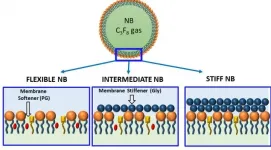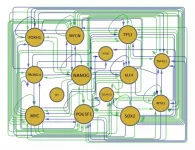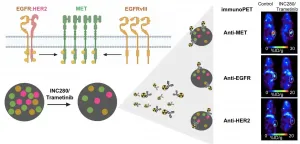(Press-News.org) Water is perhaps Earth's most critical natural resource. Given increasing demand and increasingly stretched water resources, scientists are pursuing more innovative ways to use and reuse existing water, as well as to design new materials to improve water purification methods. Synthetically created semi-permeable polymer membranes used for contaminant solute removal can provide a level of advanced treatment and improve the energy efficiency of treating water; however, existing knowledge gaps are limiting transformative advances in membrane technology. One basic problem is learning how the affinity, or the attraction, between solutes and membrane surfaces impacts many aspects of the water purification process.
"Fouling -- where solutes stick to and gunk up membranes -- significantly reduces performance and is a major obstacle in designing membranes to treat produced water," said M. Scott Shell, a chemical engineering professor at UC Santa Barbara, who conducts computational simulations of soft materials and biomaterials. "If we can fundamentally understand how solute stickiness is affected by the chemical composition of membrane surfaces, including possible patterning of functional groups on these surfaces, then we can begin to design next-generation, fouling-resistant membranes to repel a wide range of solute types."
Now, in a paper published in the Proceedings of the National Academy of Sciences (PNAS), Shell and lead author Jacob Monroe, a recent Ph.D. graduate of the department and a former member of Shell's research group, explain the relevance of macroscopic characterizations of solute-to-surface affinity.
"Solute-surface interactions in water determine the behavior of a huge range of physical phenomena and technologies, but are particularly important in water separation and purification, where often many distinct types of solutes need to be removed or captured," said Monroe, now a postdoctoral researcher at the National Institute of Standards and Technology (NIST). "This work tackles the grand challenge of understanding how to design next-generation membranes that can handle huge yearly volumes of highly contaminated water sources, like those produced in oilfield operations, where the concentration of solutes is high and their chemistries quite diverse."
Solutes are frequently characterized as spanning a range from hydrophilic, which can be thought of as water-liking and dissolving easily in water, to hydrophobic, or water-disliking and preferring to separate from water, like oil. Surfaces span the same range; for example, water beads up on hydrophobic surfaces and spreads out on hydrophilic surfaces. Hydrophilic solutes like to stick to hydrophilic surfaces, and hydrophobic solutes stick to hydrophobic surfaces. Here, the researchers corroborated the expectation that "like sticks to like," but also discovered, surprisingly, that the complete picture is more complex.
"Among the wide range of chemistries that we considered, we found that hydrophilic solutes also like hydrophobic surfaces, and that hydrophobic solutes also like hydrophilic surfaces, though these attractions are weaker than those of like to like," explained Monroe, referencing the eight solutes the group tested, ranging from ammonia and boric acid, to isopropanol and methane. The group selected small-molecule solutes typically found in produced waters to provide a fundamental perspective on solute-surface affinity.
The computational research group developed an algorithm to repattern surfaces by rearranging surface chemical groups in order to minimize or maximize the affinity of a given solute to the surface, or alternatively, to maximize the surface affinity of one solute relative to that of another. The approach relied on a genetic algorithm that "evolved" surface patterns in a way similar to natural selection, optimizing them toward a particular function goal.
Through simulations, the team discovered that surface affinity was poorly correlated to conventional methods of solute hydrophobicity, such as how soluble a solute is in water. Instead, they found a stronger connection between surface affinity and the way that water molecules near a surface or near a solute change their structures in response. In some cases, these neighboring waters were forced to adopt structures that were unfavorable; by moving closer to hydrophobic surfaces, solutes could then reduce the number of such unfavorable water molecules, providing an overall driving force for affinity.
"The missing ingredient was understanding how the water molecules near a surface are structured and move around it," said Monroe. "In particular, water structural fluctuations are enhanced near hydrophobic surfaces, compared to bulk water, or the water far away from the surface. We found that fluctuations drove the stickiness of every small solute types that we tested. "
The finding is significant because it shows that in designing new surfaces, researchers should focus on the response of water molecules around them and avoid being guided by conventional hydrophobicity metrics.
Based on their findings, Monroe and Shell say that surfaces comprised of different types of molecular chemistries may be the key to achieving multiple performance goals, such as preventing an assortment of solutes from fouling a membrane.
"Surfaces with multiple types of chemical groups offer great potential. We showed that not only the presence of different surface groups, but their arrangement or pattern, influence solute-surface affinity," Monroe said. "Just by rearranging the spatial pattern, it becomes possible to significantly increase or decrease the surface affinity of a given solute, without changing how many surface groups are present."
According to the team, their findings show that computational methods can contribute in significant ways to next-generation membrane systems for sustainable water treatment.
"This work provided detailed insight into the molecular-scale interactions that control solute-surface affinity," said Shell, the John E. Myers Founder's Chair in Chemical Engineering. "Moreover, it shows that surface patterning offers a powerful design strategy in engineering membranes are resistant to fouling by a variety of contaminants and that can precisely control how each solute type is separated out. As a result, it offers molecular design rules and targets for next-generation membrane systems capable of purifying highly contaminated waters in an energy-efficient manner."
Most of the surfaces examined were model systems, simplified to facilitate analysis and understanding. The researchers say that the natural next step will be to examine increasingly complex and realistic surfaces that more closely mimic actual membranes used in water treatment. Another important step to bring the modeling closer to membrane design will be to move beyond understanding merely how sticky a membrane is for a solute and toward computing the rates at which solutes move through membranes.
INFORMATION:
The research was performed as part of the Center for Materials for Water and Energy Systems (M-WET), an Energy Frontier Research Center supported by the U.S. Department of Energy. The collaborative partnership includes researchers at UCSB, the University of Texas at Austin, and the Lawrence Berkeley National Laboratory.
BOSTON -- SARS-CoV-2, the virus that causes COVID-19, has mutated throughout the pandemic. New variants of the virus have arisen throughout the world, including variants that might possess increased ability to spread or evade the immune system. Such variants have been identified in California, Denmark, the U.K., South Africa and Brazil/Japan. Understanding how well the COVID-19 vaccines work against these variants is vital in the efforts to stop the global pandemic, and is the subject of new research from the Ragon Institute of MGH, MIT and Harvard and Massachusetts General Hospital.
In a study recently published in Cell, Ragon Core Member Alejandro Balazs, PhD, found that the neutralizing antibodies induced by the ...
Orono, Maine -- The origins of ice age climate changes may lie in the Southern Hemisphere, where interactions among the westerly wind system, the Southern Ocean and the tropical Pacific can trigger rapid, global changes in atmospheric temperature, according to an international research team led by the University of Maine.
The mechanism, dubbed the Zealandia Switch, relates to the general position of the Southern Hemisphere westerly wind belt -- the strongest wind system on Earth -- and the continental platforms of the southwest Pacific Ocean, and their control on ocean currents. Shifts in the latitude of the westerly winds affects the strength ...
March 12, 2021 - Financial strains like debt or unemployment are significant risk factors for becoming homeless, and even help to explain increased risk of homelessness associated with severe mental illness, reports a study in a supplement to the April issue of Medical Care. The journal is published in the Lippincott portfolio by Wolters Kluwer.
The findings "suggest that adding financial well-being as a focus of homelessness prevention efforts seems promising, both at the individual and community level," according to the new research, led by Eric Elbogen, PhD, of the US Department of Veterans Affairs (VA) National Center on Homelessness and Duke University School of Medicine. The study appears as part of a special issue on ...
Mantle cell lymphoma is a malignant disease in which intensive treatment can prolong life. In a new study, scientists from Uppsala University and other Swedish universities show that people with mantle cell lymphoma who were unmarried, and those who had low educational attainment, were less often treated with a stem-cell transplantation, which may result in poorer survival. The findings have been published in the scientific journal Blood Advances.
Patients diagnosed with a mantle cell lymphoma (MCL) where the disease has spread receive intensive treatment with cytotoxic drugs and stem-cell transplantation. In a new study, researchers looked at which people are more likely to be offered transplants, and compared survival between those ...
WINSTON-SALEM, NC - March 12, 2021 - The Wake Forest Institute for Regenerative Medicine is investigating how cats with chronic kidney disease could someday help inform treatment for humans.
In humans, treatment for chronic kidney disease -- a condition in which the kidneys are damaged and cannot filter blood as well as they should -- focuses on slowing the progression of the organ damage. The condition can progress to end-stage kidney failure, which is fatal without dialysis or a kidney transplant. An estimated 37 million people in the US suffer from chronic kidney disease, according to the Centers for Disease Control.
The American Veterinary Medical Association estimates there are about 58 million ...
If you were given "ultrasound" in a word association game, "sound wave" might easily come to mind. But in recent years, a new term has surfaced: bubbles. Those ephemeral, globular shapes are proving useful in improving medical imaging, disease detection and targeted drug delivery. There's just one glitch: bubbles fizzle out soon after injection into the bloodstream.
Now, after 10 years' work, a multidisciplinary research team has built a better bubble. Their new formulations have resulted in nanoscale bubbles with customizable outer shells -- so small and durable that they can travel to and penetrate some of the ...
(BOSTON) -- There is a great need to generate various types of cells for use in new therapies to replace tissues that are lost due to disease or injuries, or for studies outside the human body to improve our understanding of how organs and tissues function in health and disease. Many of these efforts start with human induced pluripotent stem cells (iPSCs) that, in theory, have the capacity to differentiate into virtually any cell type in the right culture conditions. The 2012 Nobel Prize awarded to Shinya Yamanaka recognized his discovery of a strategy that can reprogram adult cells to become iPSCs ...
Arlington, Va. (March 12, 2021)--A new supplement offering guidance on severe COVID-19 management in resource-limited settings is now available on the American Journal of Tropical Medicine (AJTMH) website. Pragmatic Recommendations for the Management of Hospitalized COVID-19 Patients in Low- and Middle-Income Countries was coordinated by a COVID-LMIC Task Force headed by Alfred Papali, MD, of Atrium Health, Charlotte, NC, and Marcus Schultz, MD, PhD, of Mahidol University, Bangkok, Thailand; University of Oxford, United Kingdom; and Amsterdam University Medical Centers, The Netherlands. ...
BUFFALO, N.Y. - University at Buffalo computer scientists have developed a tool that automatically identifies deepfake photos by analyzing light reflections in the eyes.
The tool proved 94% effective in experiments described in a paper accepted at the IEEE International Conference on Acoustics, Speech and Signal Processing to be held in June in Toronto, Canada.
"The cornea is almost like a perfect semisphere and is very reflective," says the paper's lead author, Siwei Lyu, PhD, SUNY Empire Innovation Professor in the Department of Computer Science and Engineering. "So, anything that is coming to the eye with a light emitting from those sources will have an image on ...
Reston, VA--Immuno-positron emission tomography (PET) imaging can provide early insight into a tumor's response to targeted therapy, allowing physicians to select the most effective treatment for patients who have cancer. The new research was published in the March issue of The Journal of Nuclear Medicine.
The research showed that immuno-PET successfully visualizes changes in different cancer receptors (receptor tyrosine kinases, or RTKs) within tumors during targeted therapies. This gives physicians a tool that can be used to evaluate the effectiveness of a treatment soon after its administration.
"When healthy cells turn into cancer cells, there is a disruption in the RTK signaling. This makes RTKs a valuable therapeutic and ...





